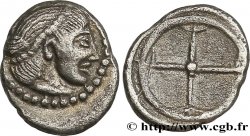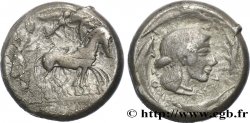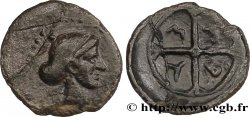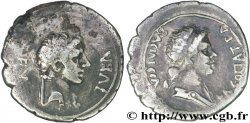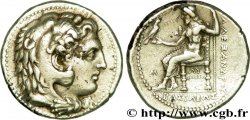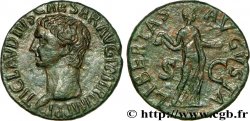v38_0064 - SICILIA - SIRACUSA Didrachme
MONNAIES 38 (2009)
Начальная цена : 450.00 €
Назначить цену : 950.00 €
непроданный лот
Начальная цена : 450.00 €
Назначить цену : 950.00 €
непроданный лот
Тип Didrachme
Дата: c. 480-475 AC.
Монетный двор / Город: Syracusa
Металл: silver
Диаметр: 20 mm
Ориентация осей монеты: 3 h.
Вес: 7,90 g.
Редкость: R3
Emission: groupe 3, série 11
Комментарии о состоянии
Exemplaire sur un petit flan épais, parfaitement centré des deux côtés. Usure importante, mais parfaitement lisible et identifiable. Beau droit archaïque. Revers un peu faible. Recouvert d’une jolie patine grise avec des reflets dorés
Ссылки в каталоге: :
Лицевая сторона
Аверс: легенда: ANÉPIGRAPHE.
Аверс: описание: Cavalier au pas à droite.
Обратная сторона
Реверс: Описание: Tête d'Aréthuse à droite, les cheveux relevés et retenus par un diadème de perles, entourée de trois dauphins.
Реверс: легенда: SURA-KOS-ION
Реверс: перевод: (de Syracuse).
Комментарий
Mêmes coins que l’exemplaire de l’American Numismatic Society (ANS. 26, pl. 1) et de la collection Jameson (n° 1907).
Same dies as the American Numismatic Society (ANS. 26, pl. 1) and Jameson Collection (No. 1907) specimen
Same dies as the American Numismatic Society (ANS. 26, pl. 1) and Jameson Collection (No. 1907) specimen








 Cообщить об ошибке
Cообщить об ошибке Распечатать страницу
Распечатать страницу Отправить мой выбор
Отправить мой выбор Задать вопрос
Задать вопрос Consign / sell
Consign / sell
 Информация
Информация
